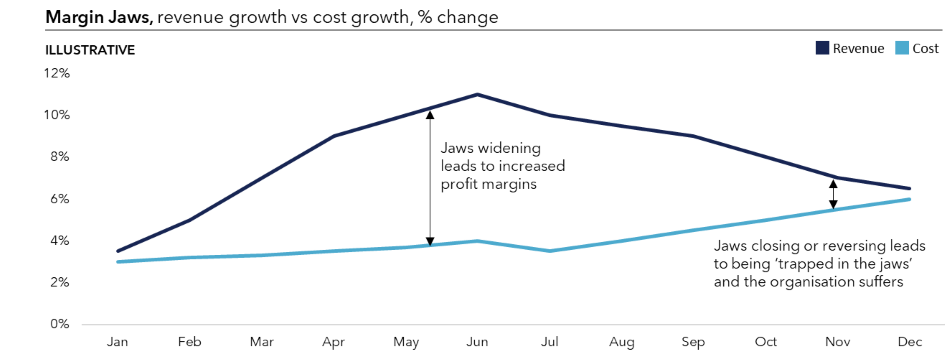May 2023
How factors are coming together to squeeze margins across Australia’s economy, and why it matters to think about your short and long term response
Macro-economic changes are driving margin compression
With apologies for stating the obvious, the Australian macroeconomic picture is challenging. Rising costs, without accompanying or insufficient revenue increases, are creating margin compression for many.
However, what is less obvious, is that approaches to margin management have come a long way since the GFC, our greatest economic challenge in living memory. As leaders you have far more options to manage your short-term cost profile in a manner that is consistent with your longer-term aspirations. We have better thinking frameworks for the challenge, better methods, and better tools.
For instance, we have the wisdom on anti-fragility, where organisations can use the pressure they are under not just to survive, but to become fundamentally stronger. We have new process and role design tools, with technology support, that help us take out waste. Furthermore, we have intelligent software agents becoming increasingly available, and they are not just ChatGPT (as impressive as that is).
The pressure to adapt is real and building

Many CEOs report that their organisations are already adjusting course in reaction to the closing of the margin jaws. Early cost-cutting interventions may include aggressive inventory management, reduction of discretionary spending, and adjustment of service levels. Some organisations are acting to directly reduce staffing costs via recruitment freezes, salary cuts and suspension of bonuses, or even emergency redundancies. In the medium term, more sustained cost reductions may be sought through geographic consolidation, rapid restructure, channel-switching, or changes to asset ownership and utilisation models, amongst other approaches.
However, poorly conceived or implemented change can be very dangerous
Rapid, disruptive change does not come without risks – and these risks can run deep. Reactive changes to structure and business processes, focused on short-term cost-cutting, can create the sort of challenges seen in the illustration below.
|
Elements of poorly executed restructures lead to… |
…Negative outcomes for you and your organisation |
|||||
|
|
|
|||||
 |
 |
 |
 |
 |
 |
|
| Unclear role design | Unclear purpose | Poor communication leading to confusion | Emotionally damaging process | Reduced organisational loyalty | Failure to follow up with key changes to make it work | |
 |
 |
 |
 |
 |
 |
|
| Poor or out-of-date metrics | Unclear rational for structuring decisions | Unclear accountabilities | Decline in customer service | Heightened risk of industrial sabotage | Loss of key personnel | |
Many good ideas, and the resulting well-intentioned change initiatives, fail to achieve the desired results due to poor execution – and these failures may leave your organisation worse off than where it started. This begs the question, if your organisation must change, but executing the obvious changes in isolation are likely to be problematic, what are the changes that can steer you through these turbulent waters – without capsizing the boat?
Reducing costs now, with a longer-term benefit
Bevington’s process analysis, over hundreds of organisations, reveals that most enterprises have substantial levels of waste (non-value adding processes) – activities that do not add value or contribute to the organisation’s mission. These sources of waste manifest across all industries and functions. Removing this waste can reduce FTE requirements or increase productivity without adding pressure to workloads, because the idea is to remove the non-value adding work. The benefits are real for your organisation, your employees, and your customers, who can experience the benefit of more streamlined processes.
By targeting waste, you can contain the execution risks that come with rapid cost-cutting initiatives. Your people know what the problems are, as they are the ones experiencing them day-to-day. If you recruit them to isolate and excise the noise, you gain their insight and simultaneously empower them with the opportunity to reduce their operational frustrations, while increasing their productivity.
But what about the long-term?
 While you may need to react quickly and tactically to the current environment to remain sustainable, at some point in the future the macroeconomic outlook will be more positive, and you want to position yourself to take advantage of this to build an organisation that can thrive long-term. Removing waste is generally a “no-regret” option, however, it is possible to do much more.
While you may need to react quickly and tactically to the current environment to remain sustainable, at some point in the future the macroeconomic outlook will be more positive, and you want to position yourself to take advantage of this to build an organisation that can thrive long-term. Removing waste is generally a “no-regret” option, however, it is possible to do much more.
 Operating model thinking is an excellent approach to take. An operating model is the sum of the parts of an organisation and how those parts work together. It incorporates all that you need to achieve your mission consistent with strategy, including structure, role design, technology, and process. Critically, operating model thinking is systems thinking, which recognises that changing just one part in isolation can have unexpected consequences. By considering the whole, rather than isolated factors, you can identify the system-level opportunities to institute powerful change.
Operating model thinking is an excellent approach to take. An operating model is the sum of the parts of an organisation and how those parts work together. It incorporates all that you need to achieve your mission consistent with strategy, including structure, role design, technology, and process. Critically, operating model thinking is systems thinking, which recognises that changing just one part in isolation can have unexpected consequences. By considering the whole, rather than isolated factors, you can identify the system-level opportunities to institute powerful change.
For example, changing your geographic footprint may represent an immediate cost saving, but it could also lead to negative customer reactions or erosion of key process dependencies whose reliance on the existing organisational structure was not immediately obvious. By taking a holistic view, you see the synergies and interdependencies and the overall pathways through which your organisation delivers value.
 Beginning with smaller changes – focused on the elimination of waste – can warm up your teams for action with some early successes. This process may also reveal where you might need some additional capacity. As you liberate time from reduced waste, you can start to reinvest some of that capacity into deeper operating model change. For instance, waste may be removed from a process, but your next step might be to introduce intelligent automation, thus fundamentally changing the cost and capacity profile of that process.
Beginning with smaller changes – focused on the elimination of waste – can warm up your teams for action with some early successes. This process may also reveal where you might need some additional capacity. As you liberate time from reduced waste, you can start to reinvest some of that capacity into deeper operating model change. For instance, waste may be removed from a process, but your next step might be to introduce intelligent automation, thus fundamentally changing the cost and capacity profile of that process.
In conclusion
The approaches to margin management have come a long way since the GFC. The challenge for leaders is to access what we now know about how to deal with difficulties as an opportunity for deeper changes which enhance longer term resilience. In this brief paper we have outlined one path to doing so, however, there are others. For more perspectives on your challenge and opportunity please feel free to contact us.
 |
Roger Perry – CEO Bevington Group One of the region’s foremost productivity improvement and organisational design experts, focused on ensuring successful organisational change, with demonstrated and quantified returns. |





